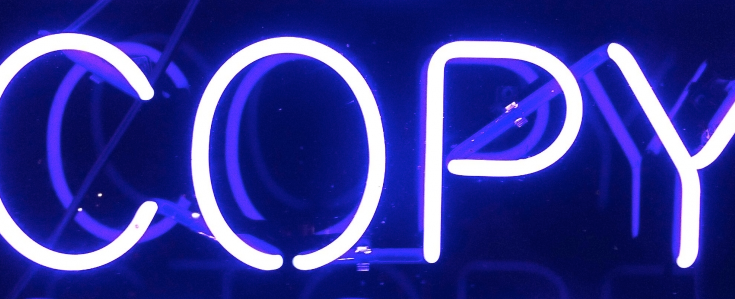Plagiarism is More Than Just Text Problem
 Last week, I posted an article entitled “5 Plagiarism Myths Many Still Believe“. While everything in the post is accurate, I did make one oversight that was quickly caught by reader Lisa Shaftel, who is both an adjunct professor and the National Advocacy Liaison for the Graphic Artist Guild.
Last week, I posted an article entitled “5 Plagiarism Myths Many Still Believe“. While everything in the post is accurate, I did make one oversight that was quickly caught by reader Lisa Shaftel, who is both an adjunct professor and the National Advocacy Liaison for the Graphic Artist Guild.
In an email, she said, “I agree with what you’ve written, although there is a major point that I think you have missed. Many people think that plagiarism applies only to literary works and written text, and not to other types of creative works. You wrote only about written works in your article, as well.”
And she’s absolutely right.
As a writer myself who got into plagiarism because of his literary works being lifted, I tend to think and write about plagiarism through that prism. However, plagiarism is an issue in literally every creative medium, including many that people don’t think about as having an issue with plagiarism.
The nation received a reminder of this earlier this week when the finale of “Ellen’s Design Challenge” aired on HGTV. A reality competition show that features furniture designers competing for a $100,000 prize, the show crowned a winner, Tim McClellan, only to revoke his prize a week later when it was discovered his desk design was similar to one created by designer Simon Schact.
While that case has proved tone very controversial among both fans and designers, the point remains, if it’s creative, it can be plagiarized and the proof of that is all around us.
So why is the conversation around plagiarism so writing-centric? The answer is surprisingly simple and complex.
An Academic Problem
While there are many reasons why so much of the focus of plagiarism is on text works, likely the biggest contributor is academia.
The first exposure most people have to the idea of plagiarism and attribution is in the classroom and that almost always has to do with written work, including essays, papers and creative writing assignments.
Partly because of this, writing is the only field where there is a clear and complete set of rules for reuse and attribution. For example, while we captions and citations for images, how would an artist like Richard Prince go about citing the photos he bases his work on? On the image itself? In the description? In the title? While there are means there are no standards he could have followed.
This becomes even more confusing in other fields. If, for example, McClellan had wanted to cite the desk he allegedly borrowed from in his design, how would he have done it? While the written language has punctuation to indicate copied passages and three major citation styles (MLA, APA and Chicago), other types of work are lucky to even have a rarely-used convention.
However, while this means non-textual plagiarism gets a lot less conversation time, it doesn’t mean that plagiarism is any less serious of an issue in those fields and the proof of that is in the vast array of plagiarism stories across the non-literary spectrum of creativity.
Plagiarism Around the Creative World
For those who don’t believe that plagiarism is a problem in other creative fields, here is just a sample of plagiarism stories from other types of creative work:
- Photography Plagiarism: I’ve talked about photography plagiarism repeatedly here, but the problem has become so widespread that entire groups, such as Stop Stealing Photos, have risen and are dedicated to calling out those who pad their portfolios with the works of others.
- Graphic Design and Artwork Plagiarism: The site Just Creative has a wonderful post highlighting a series of “too close for comfort” graphic design cases. More prominently in the news, American Eagle Outfitters was recently sued and reached a settlement with street artist Aholsniffsglue over the company’s use of his work in an advertising campaign.
- Fashion Plagiarism: Much of fashion design may not qualify for copyright protection because it’s considered a useful article. However, it certainly still can be plagiarized. The magazine Fader recently highlighted five of the biggest plagiarism scandals in the industry in 2015 but the problem has been going on well before that. For example, in 2011 Ivanka Trump was called a plagiarist over an allegedly copied shoe. However, in this industry such battles are common, not only because of deliberate knock offs, but it is an industry of trends that often pushes the boundaries of inspiration and appropriation.
- Architecture Plagiarism: While the business of big buildings might seem to be immune from plagiarism, it’s shown to be anything but. In 2013 architect Dame Zaha Hadid was faced with a daunting problem, a plagiarism of her latest office building might actually be completed before the original, both of which were being built in China. However, two years before, she faced accusations that she drew a bit too much inspiration from a screen at Kennedy Airport. Plagiarism in architecture is nothing new, but the standards and definitions are still very much up for debate.
- Film Plagiarism: For talk of film plagiarism one doesn’t need to look much farther than Shia Labeouf and his plagiarism scandal in late 2013 where his short film Howard Cantour was revealed to be an almost panel-by-panel plagiarism of Daniel Clowes graphic novel Justin M. Damiaono. However, it’s been India’s filmmaking scene, referred to as Bollywood, that has attracted the lion’s share of plagiarism allegations including this list of films that lifted heavily from other movies. Even today British author Jeffrey Archer is in the news for venting his frustration of Bollywood adaptations of his stories.
- Music Plagiarism: Allegations of music plagiarism have been in the news a great deal lately. Recently, Sam Smith settled a dispute with Tom Petty over allegations Smith’s Stay With Me contained elements from Petty’s I Won’t Back Down and, even as I’m writing this, Robin Thicke and Pharrell Williams are arguing that their hit, Blurred Lines is not a plagiarism and infringement of Marvin Gaye’s Got to Give it Up in a court.
- Software Plagiarism: Previously I wrote about plagiarism in the video game industry but much of that centered around the growing collection of clones and imitation games. Software also has an issue with programmers simply lifting code from others without attribution, so much so a variety of tools for detecting plagiarism in code have been created. But as software becomes more and more complex, the issue extends not just to the code, but the images, sounds and animations contained within it, opening up still more possibilities for plagiarism. In the meantime, the Google/Oracle case looks at the copying of Application Programming Interfaces (APIs) and whether that’s a copyright infringement or not.
All of these fields listed and we still have barely scratched the surface of the types of plagiarism that are possible and have taken place. In short, if it can be seen as a creative work, it likely can and has been plagiarized. It’s that simple.
Bottom Line
Though, with this site, I’ve tried to take a more broad view on plagiarism, inevitably there is a text-centric view of the topic both because of my background and the nature of the conversation in general.
However, that focus shortchanges creatives in a variety of fields, not just by the lack of attention, but the lack of focus on developing tools and services to help detect, prevent and stop it.
Worst of all, this hurts the conversations that are necessary for these other types of works to develop attribution codes and standards that can make appropriate reuse possible and clearly define what is or is not plagiarism.
For my part in that, I am sorry and I will do better with it in the future. However, it’s clear we all have a long road to go before this issue is truly addressed.
But that change starts here.
Want to Reuse or Republish this Content?
If you want to feature this article in your site, classroom or elsewhere, just let us know! We usually grant permission within 24 hours.
